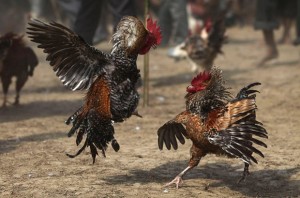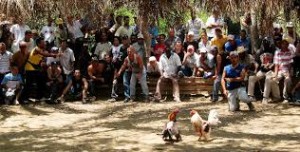COCKFIGHTING IN CUBA TODAY, TRADITION THAT WILL NOT DISAPPEAR.
The desire to preserve the cultural traditions often collides with new conceptions of modernity. Without touching the subject of superstition, which is easy to realize the obsolescence of certain habits, such as covering mirrors when a deceased in the home, or do the cleaning at the end of the year throwing a bucket of water into the street, there many customs endangered under the new ecological awareness throwing a criticism of our relations with the rest of nature look.
One such national traditions are cockfighting. Belligerent animal, the rooster was identified as a symbol of rebellious Cuban who does not give up in the fight to see his opponent removed. For reasons never fully explained, fences de gallo, a sort of Roman Coliseum minimum scale, were banned in the early years after the triumph of the Revolution. But no one has explained what not, have returned under the two forms in which it manifests especially in Cuba, via the state and illegally.
In this our version of the bullfight in the arena there are two contending animals, but they do instigated by men, who are trained and stoke to produce a spectacle of high content of violence and almost always bloody. And I say “men” because there are rarely women and because generally the presence of minors is prohibited.
in the streets of the city of Holguin it is common to see children fighting cocks, a practice that has proliferated across the province without the authorities involved
However, in the streets of the city of Holguin it is common to see children fighting cocks, a practice that has proliferated across the province without the authorities involved.
Jose Enrique Chacon is one of these infants. With only eight years old he has already made money thanks to the victories of his cock. For it has been dedicated to care for and train your champion, an animal that his grandfather had the idea of giving with the intention of maintaining a family tradition handed down from generation to generation.
The boy says he knows about what he learned from his father, who still could not accompany the biggest hurdle in the province, located in La Flora, a town 20 kilometers south of the capital municipality and administered over 15 years ago by the National Enterprise for the Protection of Flora and Fauna, entity led by Commander Guillermo Garcia Frias.
https://youtu.be/VuKQlMY_Oe0
However, Jose Enrique frequent clandestine fences where he gained experience in the art of fighting cocks. As part of training, the child confronts his animal against another who was blinded product fights to his father subjected him. One of the tactics used during the fighting is steady the animal is yelling “pica and pulls my cock” phrase that calls to kill the opponent.
Many agree that this is the Cuban province with greater root and tradition of cockfighting, which is why in March a regional tournament here, cockers event attended by all the eastern provinces is held.
14yMedio, Havana / Donate Fernando Ochoa, Holguin / InternetPhotos.
The Cuban History, Hollywood.
Arnoldo Varona, Editor.
PELEAS DE GALLOS HOY, TRADICIÓN CUBANA QUE NO DESAPARECERÁ.
El afán por conservar las tradiciones culturales choca a menudo con nuevas concepciones de la modernidad. Sin tocar el tema de las supersticiones, donde es fácil darse cuenta de la obsolescencia de ciertos hábitos, como cubrir los espejos cuando hay un fallecido en el hogar, o hacer la limpieza de fin de año lanzando un cubo de agua hacia la calle, hay muchas costumbres en vías de extinción en virtud de esa nueva conciencia ecológica que lanza una mirada crítica hacia nuestras relaciones con el resto de la naturaleza.
Una de esas tradiciones nacionales son las peleas de gallos. Animal beligerante, el gallo fue identificado como un símbolo del cubano contestatario que no ceja en el combate hasta ver eliminado a su contrincante. Por razones nunca bien explicadas, las vallas de gallo, especie de coliseo romano a mínima escala, fueron prohibidas en los primeros años después del triunfo de la Revolución. Pero, sin que nadie lo haya explicado tampoco, han regresado bajo las dos formas en que se manifiesta todo en Cuba, por la vía del Estado y de forma ilegal.
En esta versión nuestra de la corrida de toros, en el ruedo hay dos animales contendiendo, pero lo hacen instigados por los hombres, que los entrenan y azuzan para producir un espectáculo de alto contenido de violencia y casi siempre sangriento. Y digo “los hombres” porque rara vez hay mujeres y porque por regla general se prohíbe la presencia de menores de edad.
en las calles de la ciudad de Holguín es común ver a niños peleando gallos, una práctica que ha proliferado en toda la provincia sin que las autoridades intervengan
No obstante, en las calles de la ciudad de Holguín es común ver a niños peleando gallos, una práctica que ha proliferado en toda la provincia sin que las autoridades intervengan.
José Enrique Chacón es uno de estos infantes. Con solo ocho años de edad ya ha ganado dinero gracias a las victorias de su gallo. Para ello se ha dedicado a cuidar y a entrenar a su campeón, un animal que su abuelo tuvo la ocurrencia de regalarle con la intención de mantener una tradición familiar transmitida de generación en generación.
El niño dice que lo que sabe sobre el tema lo aprendió de su padre, a quien todavía no ha podido acompañar a la valla más grande de la provincia, situada en La Flora, un poblado a 20 kilómetros al sur del municipio cabecera, y administrada desde hace más de 15 años por la Empresa Nacional para la Protección de la Flora y la Fauna, entidad dirigida por el comandante Guillermo García Frías.
https://youtu.be/VuKQlMY_Oe0
Sin embargo, José Enrique frecuenta vallas clandestinas donde ha adquirido experiencia en el arte del combate de gallos. Como parte del entrenamiento, el niño enfrenta a su animalito contra otro que quedó ciego producto de las peleas a las que su padre lo sometió. Una de las tácticas que utiliza durante los combates es gritarle contantemente al animal “pica y tira mi gallo”, frase con la que exhorta a matar al rival.
Muchos coinciden en afirmar que esta es la provincia cubana con mayor arraigo y tradición en las peleas de gallo, motivo por el cual en el mes de marzo aquí se celebra un torneo territorial, evento al que asisten galleros de todas las provincias orientales.
14yMedio, Havana / Donate Fernando Ochoa, Holguin / InternetPhotos.
The Cuban History, Hollywood.
Arnoldo Varona, Editor.



 COCKFIGHTING in Cuba Today, Tradition that will not disappear. *** Peleas de Gallos en Cuba, Tradición que no desaparecerá.
COCKFIGHTING in Cuba Today, Tradition that will not disappear. *** Peleas de Gallos en Cuba, Tradición que no desaparecerá.

